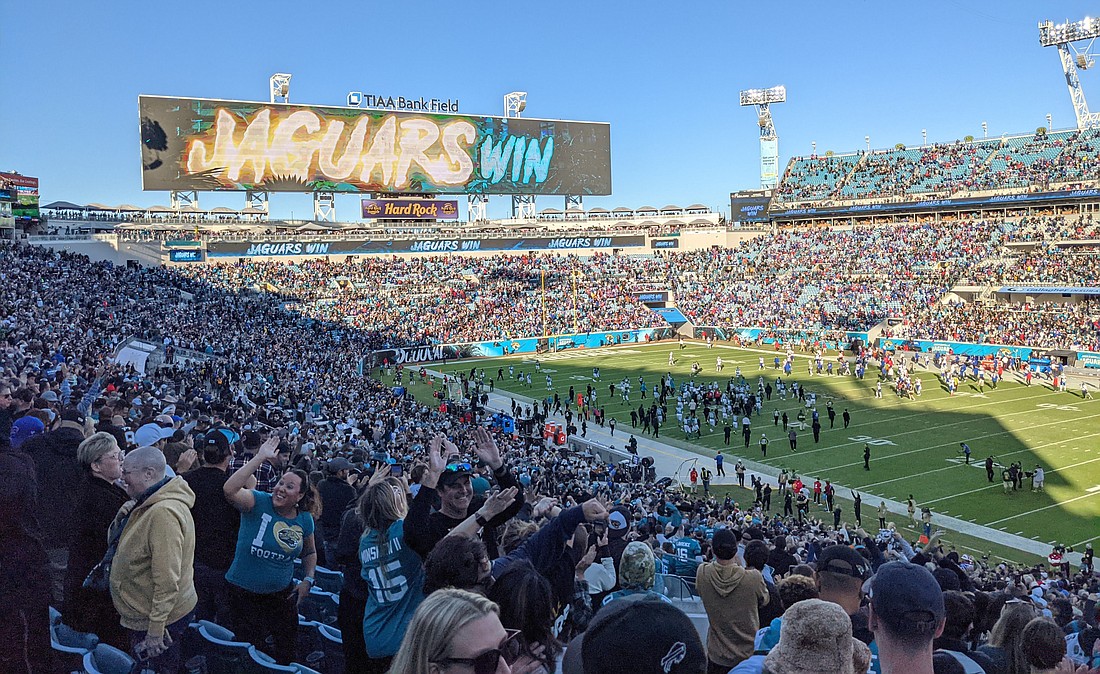
As the Jacksonville Jaguars inch toward a plan to renovate TIAA Bank Field, the NFL team released survey results July 12 that show team performance and lack of shade are key factors in ticket holders’ overall stadium experience.
The survey conducted by CAA Icon Strategy Group and completed May 18 is the latest sign that the Jaguars likely will seek a full renovation of the city-owned stadium by the time the team’s lease expires in 2030.
CAA Icon completed 5,842 web-based surveys for the feasibility study. About 51% of the respondents were season ticket holders, and 47% of the nonseason ticket holders surveyed owned them at one time.
The report shows that 89% of those who responded to the survey would support renovating TIAA Bank Field, and 78% said they would be more likely to attend a Jaguars game in a renovated stadium.
Of those surveyed, 81% said there should be shade coverage for all seats, 63% said all seating should have rain coverage, and 69% want to see improved air flow.
The team’s on-field performance and ticket affordability were the most important aspect of the game-day experience.
Of the former season ticket holders who responded, 64%, or 856, said the Jaguars’ game play was the main reason they stopped purchasing them.
In addition to heat and the lack of shade and a better team on the field, the survey shows respondents who are not generally satisfied with the current stadium also want:
• Better concession pricing and variety.
• Bigger seat sizes.
•More general admission amenities.
The least important improvements would be a fantasy football lounge and a family seating section, the survey says.
The Jaguars released the survey results to subscribers of its online Downtown development campaign 1stDowntown Jacksonville in an email titled “Stadium of the Future Update.”
Jaguars President Mark Lamping says an assessment of the stadium by Haskell shows renovating the structure is feasible. He told reporters Dec. 13, that model could save $600 million in construction costs over a new facility.
According to CAA Icon, 53% of those surveyed had annual household income exceeding $100,000, and 31.2% made more than $150,000.
The largest group responding to the survey were 50- to 64-year-olds at 22.2%, followed by the 35- to 44-year-old demographic at 21.4%. People age 45 to 54 accounted for 20.6%.
CAA Icon also conducted three focus groups and held corporate interviews, according to the survey cover letter addressed to Lamping and Jaguars Development Projects Director Will Tutwiller.
The Jaguars said in its email they received input from annual stadium users like the University of Florida and the University of Georgia, stadium events operator ASM Global and unnamed people interested in Downtown development.
The city and the Jaguars have expressed interest in booking a College Football Playoff game should the NCAA expand the playoff bracket.
The email says the Jaguars “sought to better understand” the requirements of a CFB playoff host and found the stadium needs 65,000 seats and a roof structure that protects the playing field from any rain.
Currently, TIAA Bank Field has 67,000 seats.
The results of the survey came with a disclaimer:
“Although the findings included herein appear reasonable based on current and anticipated market conditions, actual results depend on the actions of management and other factors both internal and external to the Jaguars,” it said.
“It is important to note that because events and circumstances may not occur as expected, there may be significant differences between the actual results and those estimated in the analysis, and those differences may be material.”
The stadium update email repeats what Lamping told news reporters June 13 at its the team’s new training and practice facility, the Miller Electric Center, groundbreaking that the team’s next step is a stadium design.
The email says the Jaguars have engaged eight “world-class” architectural firms to provide a concept for the next stadium and estimate construction pricing.
The Jaguars told its 1stDowntown Jacksonville subscribers it will:
• Advance a new stadium conceptual design
• Get consensus on a stadium vision through public outreach
• Obtain construction cost estimates and develop a potential partnership structure with the city.